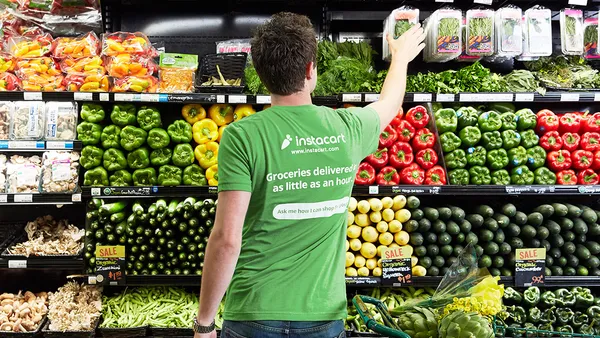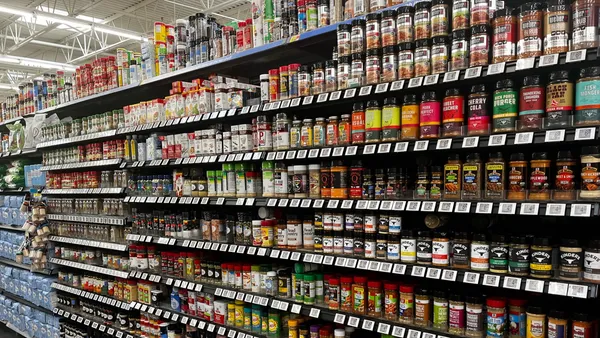Greener grocer pastures: The intersecting paths of green policies and financial returns
Grocers have invested significantly in the pursuit of sustainability initiatives – initiatives as varied as Zero Hunger, Zero Packaging Waste, Zero Plastic Bags, Building Net Zero, and the list continues. As laudable as each of those goals individually are, and as much as they collectively resonate with end-customers, for many retailers the connection between sustainability goals to financial ones is less clear.
And in a grocery industry boasting the slimmest of margins, most grocers do not have the luxury of excess dollars or excess time to invest in sustainability policies with unclear, or worse yet, negative results to the bottom line. As such, a beginning focus on cost line items, such as energy expenditures, which have clear connection both to sustainability and environmental goals, as well as financial expenses is a logical and impactful first area of focus. Research from The Ratio Institute, for example, found that a $1 decrease in electrical costs had the same effect on a grocer’s gross profits as $18 in sales.
And the grocery industry is at a pivotal juncture, grappling with rising operational costs, impending regulations, and a heightened urgency for sustainable solutions. On top of that, consumer behavior and demands are changing, with online orders, curbside pickup, and grocery delivery becoming more prevalent.
Refrigeration lies at the center of all of these issues, as grocery stores look for decentralized options to help them maintain profitability in the coming years.
Related read: How Grocers Can Meet Growing Curbside Pickup Demand
The real cost of the current solution:
Here's the reality, commercial refrigeration is a major expense in the day-to-day operations of grocery stores. Refrigeration units not only represent a significant initial investment for the stores, but they are also costly to maintain and operate. On average, for example, a 2 door reach-in Refrigerator or Freezer unit can cost anywhere from $2,000 to $10,000, and its not uncommon for a grocery store to have ten or more units. Ongoing maintenance and operating costs for those same units adds additional costs, ranging from $100-$700 per unit per year.
No matter where you are, that cost takes a significant bite out of any grocery store’s profit margin. And when you consider that large refrigeration units are almost never full, that money is being spent on refrigerating empty space. That points to an opportunity to used decentralized solutions to dramatically reduce operation costs.
Related read: A Grocer’s Guide to Boosting Business: Top 5 trends, Insights and Actions
The regulatory landscape: EPA’s Take on Refrigeration
Refrigerants make it possible to keep food cold or frozen and prevent spoilage, but they also contribute to environmental degradation. The leakage of these substances depletes the ozone layer and amplifies the effects of global warming, creating an environmental impact 2,000 times greater than that of carbon dioxide (CO2).
Additionally, refrigeration and air conditioning systems require tremendous amounts of energy to operate. That energy is typically generated by fossil fuel sources, which increases CO2 emissions and contributes to global warming. The United States Environmental Protection Agency (EPA) has established a strong position on this issue, detailed in the agency’s guide on Refrigerant Transition & Environmental Impacts.
The EPA is initiating the phase-out of harmful refrigerants such as HFC-134a. This is being implemented through programs like the Significant New Alternatives Policy (SNAP) program, which provides guidance to retailers on legal and eco-friendly cooling agents.
Retailers are mandated to report any refrigerant leakages that exceed a specified limit within a year, with failure to comply resulting in hefty fines. With the forthcoming federal regulations set to significantly reduce the usage of certain refrigerants, the grocery retail sector is on the verge of undergoing a major transformation. Given this environment, many grocery retailers are unsure what to do. They don’t know if they are prepared to meet the new regulations and operate within the bounds of the law.
The rise of hydrocarbon refrigeration: Is propane the answer?
Growing environmental concerns are propelling the food retail sector toward alternatives to traditional refrigerants, steering attention towards hydrocarbon-based refrigerants, particularly propane and isobutane, across North America.
Hydrocarbon refrigerants are often touted as “natural,” which obscures their significant problems. While it’s true they are more environmentally friendly than HFCs, they still have dangerous trade-offs. They are flammable, toxic, and corrosive. They require special handling for transportation and storage, making them more expensive, and they also pose significant environmental risks of their own.
This puts retailers in a difficult situation, facing the opposing challenges of traditional refrigerants and hydrocarbons, with no apparent solutions. They need a refrigeration option that addresses these problems while giving them the flexibility they need to adapt to a changing marketplace.
Scalable, flexible and sustainable: Phononic refrigeration solutions for the grocery industry
Emerging technologies are revolutionizing the grocery retail landscape, introducing innovative solutions that tackle both environmental and operational challenges.
One of the standout innovations is the advent of Phononic refrigerator and freezer totes. These actively cooled totes are proving to be a game-changer, especially for curbside pickup and delivery services. Similarly, new, environmentally friendly refrigerants are also being developed and approved. These alternatives are not only better for the planet but are also in line with new regulations, ensuring that grocery stores have options that are both legal and green.
The Phononic totes are particularly promising for grocery stores because they offer on-demand cooling that can be scaled up or down to meet the natural peaks and valleys of customer demand. That kind of flexibility is not possible with standard, reach-in refrigeration units.
A creative solution to a growing challenge, they present grocery retailers with opportunities to complement their existing center store refrigeration units. This integration promises tangible benefits including cost savings, environmental gains, and enhanced customer satisfaction, tapping into the growing trend of curbside pickup.
Early adopters of the Phononic solution are already seeing their value. One large U.S. grocer adopted the Phononic solution, and within weeks was able to double their sales volume in a footprint half the size.
Retailer savings
The introduction of these innovative cooling units is transforming the retail space. By offering up to 50 percent in space savings, they are opening up a world of benefits for retailers. This reduction in required space means retailers can either repurpose the saved area for additional revenue-generating activities or choose to reduce their overall operational footprint, saving on build-out and maintenance costs.
Additionally, the strategic placement of these units can help increase labor efficiency. They reduce the number of times staff members need to handle products to stage and consolidate orders, because whole orders can be staged together. That saves valuable time and helps stores reduce their labor costs.
The on-demand cooling capabilities of these units translate directly into cost savings. Unlike larger, traditional refrigeration units that need to be powered constantly, regardless of the volume of goods being stored, these innovative solutions allow retailers to power just the cooling they need, when they need it.
As demand fluctuates, these units can be easily scaled up or down, ensuring that retailers can meet growing customer needs as they arise without having to scramble to make costly and time-consuming changes to their refrigeration infrastructure.
Related read: Maximizing Space for In-Store, Curbside Grocery Pickup: A Guide for Grocers
Note: Source
Elevated Customer Experience
Innovative cooling solutions significantly enhance curbside pickup and delivery services, ensuring optimal food storage conditions, and reducing spoilage and order mix-ups. This boosts order accuracy and customer satisfaction. The reliable cooling environment keeps perishable goods fresh from store to doorstep. Strategic placement and efficient cooling reduce order preparation time, especially during peak demand, improving the customer experience.
Integration with advanced software provides real-time updates on order status and food conditions, fostering trust and giving customers control over their shopping experience. Ultimately, these solutions optimize curbside and delivery services, ensuring timely, accurate deliveries and enhancing the retailer’s reputation.
Data-informed decision making
These units can also revolutionize inventory management – an important process for grocery stores – through real-time analytics and data insights. This creates a world of possibilities for retailers, including the ability to offer their customers real-time visibility into when their online orders were picked, which employees picked them, and their verified temperature.
They can also use the data to optimize their operations, using insights into energy use, labor efficiency, and inventory to make informed decisions about their business, reducing costs and gaining a competitive edge.
Minimized environmental impact
By utilizing CO2 and water, these units markedly decrease environmental damage caused by traditional HFC (Hydrofluorocarbon) refrigerants – representing a monumental shift from traditional systems.
CO2 has emerged as a potent solution in sustainable refrigeration, bringing forth several advantages. Unlike HFC’s with their high Global Warming Potential (GWP), CO2 boasts a GWP of just 1, making it an eco-friendly option.
When evaluating the environmental benefits of sustainable refrigeration, it’s crucial to consider the entire lifecycle and recyclability of the systems. Traditional refrigeration systems pose challenges during operation and at the end of their life due to difficulties in recycling and potential environmental damage from discarded materials.
In contrast, sustainable systems, including CO2 refrigeration, offer extended lifespans due to technological and material advancements, are designed with eco-friendly materials that are easier to recycle or repurpose, and result in reduced landfill waste, thereby lessening their overall environmental impact.
The urgency for sustainable commercial grocery refrigeration
In an industry characterized by razor-thin margins, adopting innovative solutions has become imperative for grocers of all sizes grappling with impending regulatory changes and shifting consumer expectations. The uncertainty around what regulations will come into play and when, coupled with the unique challenges each grocer faces, underscores the necessity of a proactive approach.
While there isn’t a one-size-fits-all solution, the benefits of exploring new, sustainable cooling technologies are undeniable. Engaging in a process of testing and learning tailored to the specific realities of one’s business is crucial for identifying the most optimized solution. This approach ensures that decisions are data-driven and catered to the unique needs of each retailer.
Although challenges are present, there is a window of opportunity for a shift towards systems that are sustainable, efficient, and cost-effective.
Grocers must adapt to these emerging technologies, not only to stay competitive and meet regulatory demands but also to contribute to system-wide optimization that is imperative for future success. The time for change and adaptation is now, as the industry continues to evolve and navigate through these transformative times.
Learn more: Discover Sustainable Cooling Solutions for the Future of Grocery Retail










